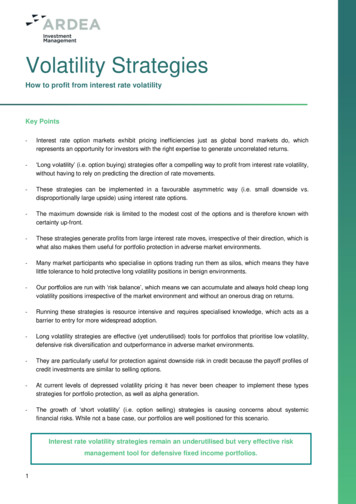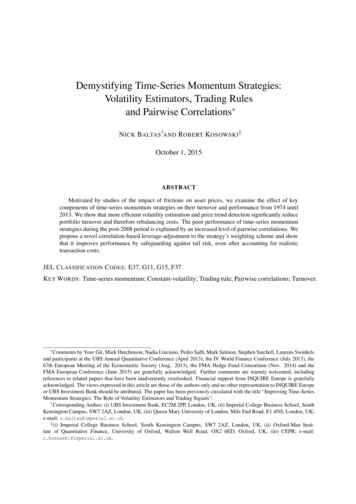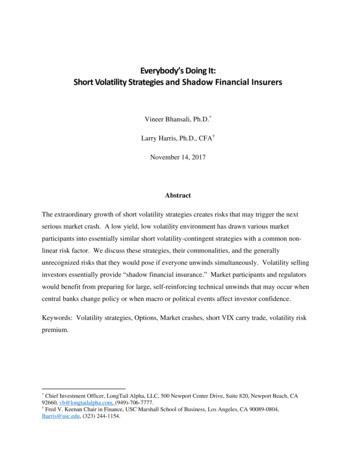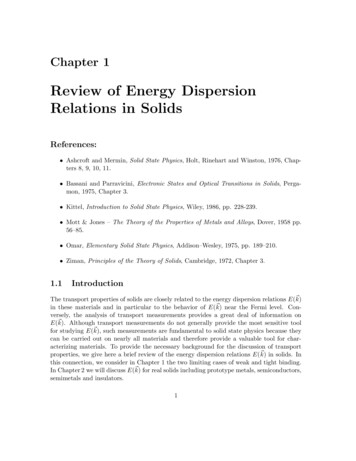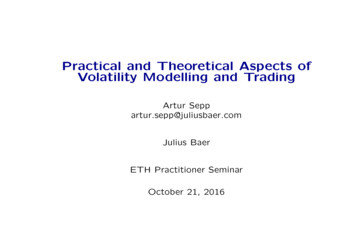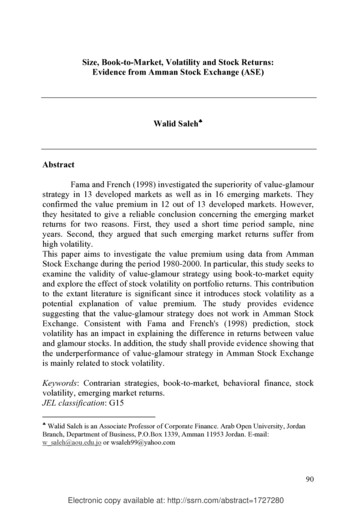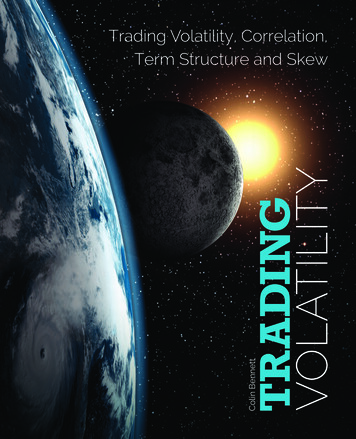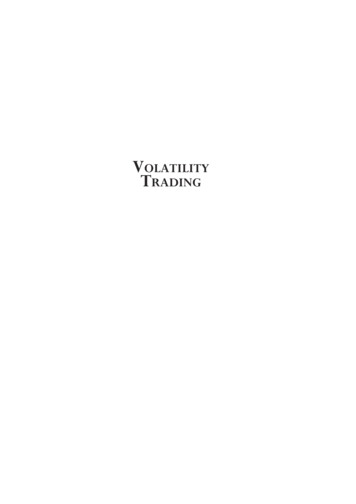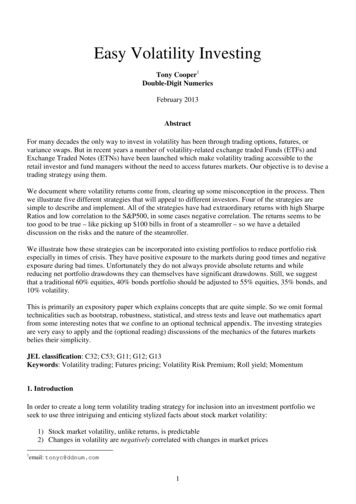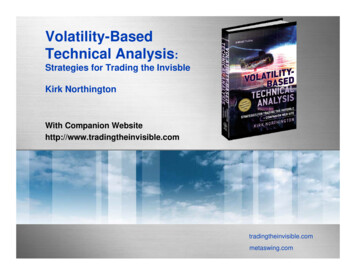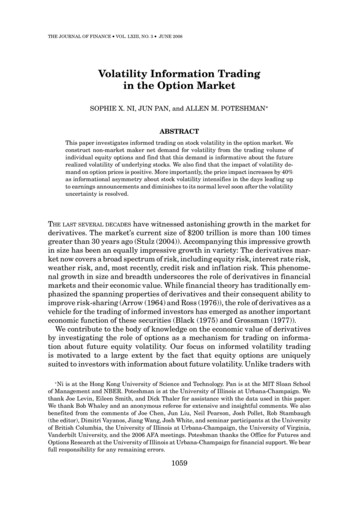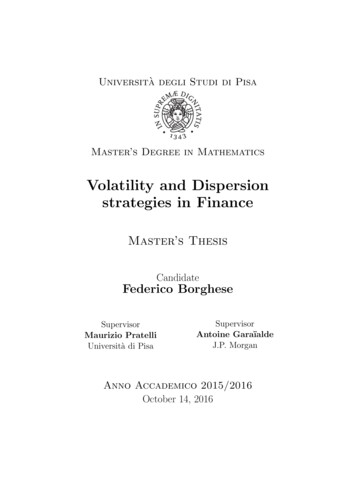
Transcription
Università degli Studi di PisaMaster’s Degree in MathematicsVolatility and Dispersionstrategies in FinanceMaster’s ThesisCandidateFederico BorgheseSupervisorMaurizio PratelliUniversità di PisaSupervisorAntoine Garaı̈aldeJ.P. MorganAnno Accademico 2015/2016October 14, 2016
Università degli Studi di PisaMaster’s Degree in MathematicsVolatility and Dispersionstrategies in FinanceCandidateFederico Borghese1SupervisorMaurizio PratelliUniversità di PisaSupervisorAntoine Garaı̈aldeJ.P. MorganOctober 14, 20161Equity Derivatives Structuring at J.P. Morgan - Università di Pisa - Scuola NormaleSuperiore - M2 Probabilités et Finance (Paris 6 & École Polytechnique).Contact: fed.borghese@gmail.com
Contents1 J.P. Morgan Equity Derivatives Structuring1.1 J.P. Morgan . . . . . . . . . . . . . . . . . .1.2 Equity Derivatives Structuring . . . . . . . .1.2.1 A bridge between Trading and SalesGroup. . . . . . . . . . . . . . . . . . . . . . . . . . . .2 Preparatory concepts2.1 European Payoff replication with vanilla options2.1.1 Proof . . . . . . . . . . . . . . . . . . . .2.2 Ito-Tanaka’s formula . . . . . . . . . . . . . . .2.3 Gamma P&L . . . . . . . . . . . . . . . . . . .2.4 Basket of n stocks . . . . . . . . . . . . . . . . .3 Volatility products3.1 Introduction . . . . . . . . . . . . . . . . . . . . . . . . . . . .3.1.1 Implied Volatility . . . . . . . . . . . . . . . . . . . . .3.1.2 Realized Volatility . . . . . . . . . . . . . . . . . . . .Realised volatility in a stochastic volatility model . . .3.2 Variance Swaps . . . . . . . . . . . . . . . . . . . . . . . . . .3.2.1 Replication and fair strike of a Variance Swap . . . . .3.2.2 Sensitivities . . . . . . . . . . . . . . . . . . . . . . . .Vega . . . . . . . . . . . . . . . . . . . . . . . . . . . .Delta . . . . . . . . . . . . . . . . . . . . . . . . . . . .Gamma . . . . . . . . . . . . . . . . . . . . . . . . . .Theta . . . . . . . . . . . . . . . . . . . . . . . . . . .Vanna . . . . . . . . . . . . . . . . . . . . . . . . . . .3.2.3 Derivation of the replication in a stochastic volatilitymodel . . . . . . . . . . . . . . . . . . . . . . . . . . .The realized variance is the sum of a delta strategy anda log contract . . . . . . . . . . . . . . . . . .The log contract can be replicated with a strip of vanillaCalls and Puts . . . . . . . . . . . . . . . . .5888911111213141519192020222223242526262627272728
Federico Borghese3.3Volatility and Dispersion strategies in Finance.28283032333435373737383840414243444 Correlation4.1 Different types of correlations . . . . . . . . . . . . . . . . . .4.1.1 Pearson Correlation . . . . . . . . . . . . . . . . . . . .4.1.2 Kendall and Spearman Correlation . . . . . . . . . . .Spearman Correlation . . . . . . . . . . . . . . . . . .Kendall Correlation . . . . . . . . . . . . . . . . . . . .Relationship with Pearson correlation for Gaussian vectors . . . . . . . . . . . . . . . . . . . . . . .Example: spot/div correlation . . . . . . . . . . . . . .4.1.3 Correlation in the Black-Scholes model . . . . . . . . .4.1.4 Realised correlation and Picking Frequency . . . . . . .The Picking Frequency correlation still estimates correlation . . . . . . . . . . . . . . . . . . . . .Why using Picking Frequencies . . . . . . . . . . . . .4.2 Correlation of n 2 assets . . . . . . . . . . . . . . . . . . . .4.2.1 Average Pairwise Correlation . . . . . . . . . . . . . .4.2.2 Clean and Dirty Correlations . . . . . . . . . . . . . .Realized volatility of the basket . . . . . . . . . . . . .4545454747475 Dispersion5.1 Interest in trading correlation . . . . . . . . . . . . . . . . . .5.2 General Dispersion Trade . . . . . . . . . . . . . . . . . . . . .5.3 Gamma P&L . . . . . . . . . . . . . . . . . . . . . . . . . . .595960613.4Variations of Variance Swaps . . . . . . . . . . .3.3.1 Corridor Variance Swaps Definitions . .3.3.2 Up Variance Replication . . . . . . . . .3.3.3 Weighted Variance Swap replication . . .3.3.4 Gamma Swaps . . . . . . . . . . . . . .Weighted additivity property for GammaSensitivities . . . . . . . . . . . . . . . .3.3.5 Corridor Variance Swap Replication . . .3.3.6 Re-finding the Variance Swap . . . . . .3.3.7 Volatility Swaps . . . . . . . . . . . . . .Strike of a Volatility Swap . . . . . . . .Backtest . . . . . . . . . . . . . . . . . . . . . .3.4.1 Replication with 4 options, step 10% . .3.4.2 Replication with 8 options, step 5% . . .3.4.3 Replication with 6 options, step 25% . .3.4.4 Replication with 8 options, step 10% . .3.4.5 Replication with 18 options, step 5% . .6. . . . . . . . . . . . . . . .Swaps. . . . . . . . . . . . . . . . . . . . . . . . . . . . . . . . . .48495152535355565658
Federico Borghese5.45.5Volatility and Dispersion strategies in FinanceExamples of Dispersion Strategies . . . . . . . . . .5.4.1 Variance Swap VS Variance Swap DispersionWeightings . . . . . . . . . . . . . . . . . . .5.4.2 Synthetic Variance Swap Dispersion . . . . .5.4.3 ATM Call VS Call Dispersion . . . . . . . .5.4.4 Straddle VS Straddle or Put VS Put . . . .5.4.5 Call Strip VS Call Strip . . . . . . . . . . .Backtest . . . . . . . . . . . . . . . . . . . . . . . .6 Some new ideas6.1 Putting together Dispersion and Variance Replication: TheGamma Covariance Swap . . . . . . . . . . . . . . . . . . .6.1.1 Replication . . . . . . . . . . . . . . . . . . . . . . .6.1.2 Backtest . . . . . . . . . . . . . . . . . . . . . . . . .6.2 The FX-Gamma Covariance . . . . . . . . . . . . . . . . . .6.2.1 Replication . . . . . . . . . . . . . . . . . . . . . . .6.2.2 The FX-Gamma Covariance as a form of Quanto Forward Delta Hedged and FX Hedged . . . . . . . . . .6.2.3 Conclusions . . . . . . . . . . . . . . . . . . . . . . .636364656667676870.7071737777. 78. 79Conclusions80Acknowledgements82Bibliography847
Chapter 1J.P. Morgan Equity DerivativesStructuring Group1.1J.P. MorganJ.P. Morgan is one of the most respected financial services firms in the world,serving governments, corporations and institutions in over 100 countries. Thefirm is a leader in investment banking, financial services for consumers andsmall businesses, commercial banking, financial transaction processing andasset management.With a history dating back over 200 years, J.P. Morgan is one of the oldestfinancial institutions in the United States. It is the largest bank in the US,and the world’s sixth largest bank by total assets, with total assets of US 2.4trillion. It employs more than 235, 000 people worldwide.The Firm and its Foundation give approximately 200 million annually tonon-profit organizations around the world. J.P. Morgan also leads volunteerservice activities for employees in local communities.1.2Equity Derivatives StructuringEquity Derivatives Structuring focuses on developing alternative payoff profiles for a wide range of investors, running from highly sophisticated institutional investors (Hedge Funds, Asset Managers, Pension Funds, InsuranceCompanies) to less sophisticated ones (Retail). The Team designs and pricesboth new and existing structured products in the core equity derivativesspace. There is no precise definition of what alternative payoffs are; everything which is not a easily accessed by vanilla options and futures on commonasset classes can be regarded as an alternative payoff.8
Federico BorgheseVolatility and Dispersion strategies in FinanceThe product offering is very wide. It includes new derivative ideas inspiredfrom research, existing derivatives and fully tailored solutions for the clientswhich are designed according to their return expectations, their risk appetiteand their views on the market. For example, the Team offers sophisticatedinstitutional investors ideas to trade volatility, correlation and skew.The business has considerably changed after the 2008 financial crisis. Theregulator is not in favour of complexity and the range of the products hassignificantly shrunk. However, the range of possible underlyings has considerably widened and the interest from clients stays strong. J.P. Morgan developsproprietary indices which implement systematic strategies on which simplederivative products can be written, achieving simplicity and innovation atthe same time.1.2.1A bridge between Trading and SalesEquity Derivatives Structurers have the important task to price their products. The Black-Scholes model and its variations, which are widely usedfor pricing structured products, can’t keep in consideration all the possiblefactors influencing the market evolution. For example, Volatility is not deterministic, but stochastic. The market is not complete, i.e. it is not possible to perfectly replicate derivatives using theunderlying only. The are jumps in the spot price evolution. Often these jumps are dueto news such as macroeconomics news, central bank policy, politicalnews, release of a new product, quarterly reports etc. Jumps are highlyunpredictable and always set big challenges to hedging. There are transaction costs to trading the underlying and there is abid-offer spread. Not every underlying and vanilla option is available in the market.Structurers’ skills include determining these extra-model risks and incorporate them in the price.The products are sold by Sales people, who always need the lowest possibleprice to beat the competition and secure the trade with the client. After thesale, the Trading Desk has to hedge the product in order to neutralize thebank’s position and avoid any losses. Therefore the Trading Desk wants toincorporate in the price all the possible hedging risks. The goal of the pricecomputed by the Structuring Desk is to make a good compromise betweenSales and Trading.9
Federico BorgheseVolatility and Dispersion strategies in FinanceMoreover, in the product development process, the Structuring Desk needsto know both the Sales and the Trading points of view. They need to knowthe clients, the type of products which are popular in the market, they haveto find attractive payoffs and underlyings that can be advertised. But theyalso have to think about the hedging strategies, the potential sources of risk,the sensitivities, the status of the traders’ books.10
Chapter 2Preparatory conceptsThis brief chapter recalls a few mathematical tools that will be used throughout this document. We don’t report the basics of mathematical finance,which can be found in [2] and [3].2.1European Payoff replication with vanillaoptionsThis result is sometimes known as Carr’s formula. Let G : R R atwice differentiable function (can be relaxed to G being the difference oftwo convex functions or even more than that). Consider a contract on anunderlying S which pays at maturity T the amount G(ST ). This is whatis called a European payoff: the final value of the contract depends only onthe final price of the underlying, and the contract cannot be unwound beforematurity.Suppose we have a liquid market of Call and Put Options on the underlyingwith the same maturity T , with quoted prices Call(K) for every strike K S and P ut(K) for every strike K S .Then we can perfectly replicate the European Payoff G(ST ) using only azero-coupon bond, a forward contract on the underlying and the Calls andPuts in the following manner:G(ST ) G(S ) G0 (S )(ST S ) Z S Z00 G (K)(K ST ) dK S 011G00 (K)(ST K) dK(2.1)
Volatility and Dispersion strategies in FinanceFederico BorgheseAs a consequence, the only allowable price for the contract in order to preventany arbitrage isContract price G(S )B(0, T ) G0 (S )(price of a forward struck at S ) Z Z S G”(K)Call(K)dKG”(K)P ut(K)dK S 0(2.2)where B(0, T ) is the price of a zero-coupon bond with maturity T .2.1.1ProofProof. Assume that G is twice differentiable1 . By the integration by partsformula, we haveZ Z 0G”(K)(x K) dK [G (K)(x K) ]S G0 (K)1{x K} dK SSZ S Z S SG”(K)(K x) dK [G0 (K)(K x) ]0 G0 (K)1{x K} dK00(2.3)The terms in brackets evaluated at K 0 and K are equal to zero,so we can rewriteZ G”(K)(x K) dK G0 (S )(x S ) (G(x S ) G(S ))S Z S G”(K)(K x) dK G0 (S )(S x) (G(S ) G(x S ))0(2.4)By summing the previous two equations, we get:Z S Z G”(K)(K x) dK G”(K)(x K) dK S 00 (2.5) G (S )(S x) G(S ) G(x)Reordering the terms and evaluating at x ST we find back equation (2.1).1The proof is the same in the case of G being the difference of convex functions. Inthis case G has a left derivative and its second derivative in the sense of distributions (aRadon measure) satisfies the integration by parts by definition.12
Federico Borghese2.2Volatility and Dispersion strategies in FinanceIto-Tanaka’s formulaIto’s formula, one of the most useful tools in mathematical finance, is onlyvalid for C 2 functions. In the market, however, we very often deal withfunctions which are not twice differentiable. Even the simplest derivativeproduct, a Call Option, has a payoff which is not C 2 .This regularity hypothesis is very often neglected by practitioners, becausein many cases a “cheating” Ito’s formula provides the good result. In thissection we provide rigorous theorems which allow us to deal with functionsbelonging to a wider regularity class. Ito-Tanaka’s formula can be applied toall functions which are difference of convex functions.Let f : R R a convex function, and let f 0 be its left derivative. Beingf convex, the second derivative f ” in the sense of distributions is a positiveRadon measure. Let (Xt ) be a continuous semimartingale with quadraticvariation [X, X]t and take a R; we define a stochastic process (Lat )t 0 , theLocal Time of X at a:Z1 ta1[a,a ε) (Xs )d[X, X]sLt limε&0 ε 0The Local Time is an increasing, non-negative process, null at 0. Lat canbe thought as the time spent by the s
sale, the Trading Desk has to hedge the product in order to neutralize the bank’s position and avoid any losses. Therefore the Trading Desk wants to incorporate in the price all the possible hedging risks. The goal of the price computed by the Structuring Desk is to make a good compromise between Sales and Trading. 9. Federico Borghese Volatility and Dispersion strategies in Finance Moreover .
